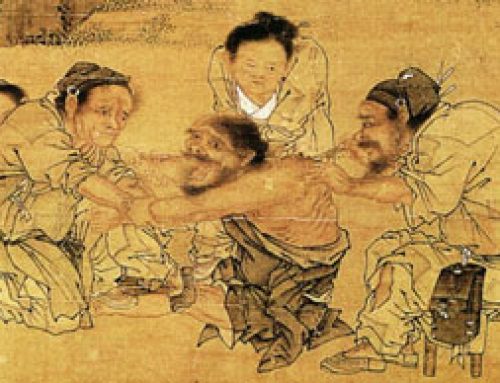
Woman beating a man
Chaucer‘s Wife of Bath’s tale is different from the other stories in the Canterbury Tales. It’s the only one told by a woman. She’s a woman from the town of Bath, in England, so it’s the Wife of Bath’s story. (Bath got that name because there were old Roman baths there). Her story presents a very different view of medieval relationships between men and women.
In the time of King Arthur and his Knights of the Round Table, the Wife of Bath begins, there was one knight who treated women very badly. One day he was found raping a girl in a field. To punish the knight, rather than kill him as the law says, Queen Guinevere tells him to go travel around the world. He should find out what women really want. She tells him to come back in a year and a day and report a satisfactory answer, or die.
Well, the knight goes out and starts asking all the women he meets what women really want. But he can’t seem to get a good answer. Some women say they want to be rich, and other women say they want lots of flattery from men. He can’t get any answers that seem like they would be true for all women.
When his year is almost over, he gives up and starts traveling back to Queen Guinevere. He thinks sadly that he is going to be killed for sure now. But he meets an old woman on the way and asks her for help. She says she’ll tell him the answer and save his life, if he’ll promise to grant her wish when she claims it. So he promises. She tells him that what women want most of all is to have power over their husbands, as well as love. Queen Guinevere agrees that this is what women want, and frees the knight.
Right away the old woman stands up and cries out that since she saved him, the knight has to marry her – that’s her wish, and she claims it now. He doesn’t want to, but he promised. So he marries her the next day.
That night, after the wedding, the old woman and the knight are talking about how unhappy he is, married to someone ugly and poor. She reveals that she’s a magic fairy, and tells the knight that he can choose between having her ugly and faithful to him, or beautiful and unfaithful. The knight wisely leaves the choice up the fairy. He tells her to choose whatever will make both of them happiest and most respected. The fairy is pleased to have this power over her husband, and decides to give him everything he wants. She becomes beautiful and faithful, and they live happily ever after.
Some things to ask yourself: what does this story show about how medieval people thought about getting old? Why does the knight think it’s so terrible that the old woman is poor? How does this concern with power relate to feudalism, the medieval system of government?
(For totally different views of medieval women, check out the other stories here.)
The Knight’s Tale
The Miller’s Tale
The Clerk’s Tale
The Wife of Bath’s Tale
Bibliography and further reading about Chaucer:
The first of these Chaucer books for kids has some stories about farts and naked bottoms in it; don’t buy it if you don’t want that. The second one has been cleaned up for children.




